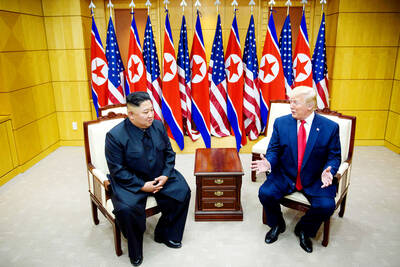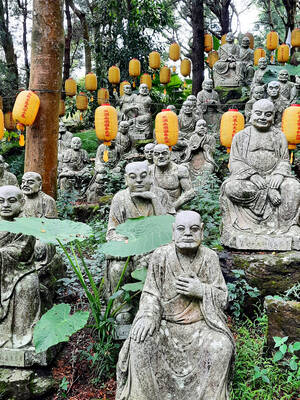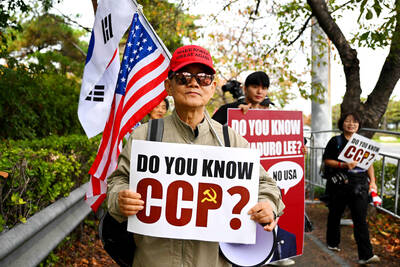Ten years ago, Japanese teacher Kazunari Uzunomiya and his wife Tomoko began to realize their dream of cycling around the world. Now, 10 years and 88 countries later, they have fulfilled their dream and are ready to face new challenges.
The couple began their round-the-world trip on a tandem bike in 1997. Katsunari had been a cycling enthusiast since childhood and had read many books about round-the-world adventures.
But Tomoko, who worked in an office, had no interest in cycling at all and was afraid of going to foreign countries and meeting strange people.
"I was scared when I thought about guns in the US, and Africa was poor and dirty. But he tricked me into going along by saying that we would ride a tandem bike so that I could sit in the back seat and peddle only when we had to climb up a road," she said.
The trip turned out to be much more strenuous, but also much more exciting and rewarding, than she expected.
"We met many good people and saw many beautiful places. I am very happy when we are on the road, and all the hardships have been worthwhile," she said.
The couple, both 39, began their trip in June 1997 in North America.
From there, they traveled to and peddled around New Zealand, Australia, South America, Europe, the Middle East and South-East Asia. On May 5, they arrived in Taiwan from the Philippines.
Between continents, they disassembled their bike and packed the parts up to be transported by ship or plane as check-in cargo.
The reason they made Taiwan the final leg of their journey is that when cycling in New Zealand in 1999, they met Taiwan cycling adventurers Lin Chi-ying (林姬瑩) and Chiang Chiu-ping (江秋萍), who invited them to visit Taiwan. Lin and Chiang, known as Vicky and Pinky among international cyclists, are teachers in their 30s. The two women have already cycled through many countries and have played host to many foreign cyclists.
After resting up at Lin's home in Taichung, the Japanese couple are peddling in central and southern Taiwan, accompanied by a dozen Taiwan cyclists, and plan to return home to Japan by ship from the Keelung Harbour on June 5.
Tomoko, who is more fluent in English than Kazunari, described the round-the-world trip as full of hardship due to their tight budget and harsh weather conditions.
"We lived on US$10 a day. In the US, we stayed in a hotel only once in six months. We ate bread for breakfast and lunch and ate canned food only for dinner," she said.
They mended their own clothes and repaired their tandem bike when necessary.
They put up with the bitter cold on the 5,000m plateau of Tibet and braved the heat of the Namibian desert. In Slovenia, they slept in their tent when the temperature was -15oC.
During the 10 years of travel, the couple returned to Japan four times to take breaks for two to three months.
Tomoko said the trip has taught her that life does not have to be as stressful and fast-paced as it is in Japan.
Kazunari and Tomoko said their decade-long odyssey was in part a rebellion against their stressful lives in Tokyo.
"We really don't like to return to the stressed life in Japan, but Japan is our home and we have to take care of our parents. So we will go home now. But maybe we will take another overseas cycling trip in a few years time," Tomoko said.
Kazunari seemed less worried because he has seen his wife transformed from a weak woman into a strong and resourceful cyclist.
"She has become stronger and healthier. She looks like a different person than before," he said.
Kazunari and Tomoko have to look for work when they return to Japan, but they are not afraid since they have traveled around the world and are willing to do anything.
Taiwan cyclists have suggested they give talks to Japanese students or write a book on their round-the-world adventure to encourage young people to realize their dreams.

US President Donald Trump may have hoped for an impromptu talk with his old friend Kim Jong-un during a recent trip to Asia, but analysts say the increasingly emboldened North Korean despot had few good reasons to join the photo-op. Trump sent repeated overtures to Kim during his barnstorming tour of Asia, saying he was “100 percent” open to a meeting and even bucking decades of US policy by conceding that North Korea was “sort of a nuclear power.” But Pyongyang kept mum on the invitation, instead firing off missiles and sending its foreign minister to Russia and Belarus, with whom it

When Taiwan was battered by storms this summer, the only crumb of comfort I could take was knowing that some advice I’d drafted several weeks earlier had been correct. Regarding the Southern Cross-Island Highway (南橫公路), a spectacular high-elevation route connecting Taiwan’s southwest with the country’s southeast, I’d written: “The precarious existence of this road cannot be overstated; those hoping to drive or ride all the way across should have a backup plan.” As this article was going to press, the middle section of the highway, between Meishankou (梅山口) in Kaohsiung and Siangyang (向陽) in Taitung County, was still closed to outsiders

President William Lai (賴清德) has championed Taiwan as an “AI Island” — an artificial intelligence (AI) hub powering the global tech economy. But without major shifts in talent, funding and strategic direction, this vision risks becoming a static fortress: indispensable, yet immobile and vulnerable. It’s time to reframe Taiwan’s ambition. Time to move from a resource-rich AI island to an AI Armada. Why change metaphors? Because choosing the right metaphor shapes both understanding and strategy. The “AI Island” frames our national ambition as a static fortress that, while valuable, is still vulnerable and reactive. Shifting our metaphor to an “AI Armada”

The Chinese Communist Party (CCP) has a dystopian, radical and dangerous conception of itself. Few are aware of this very fundamental difference between how they view power and how the rest of the world does. Even those of us who have lived in China sometimes fall back into the trap of viewing it through the lens of the power relationships common throughout the rest of the world, instead of understanding the CCP as it conceives of itself. Broadly speaking, the concepts of the people, race, culture, civilization, nation, government and religion are separate, though often overlapping and intertwined. A government